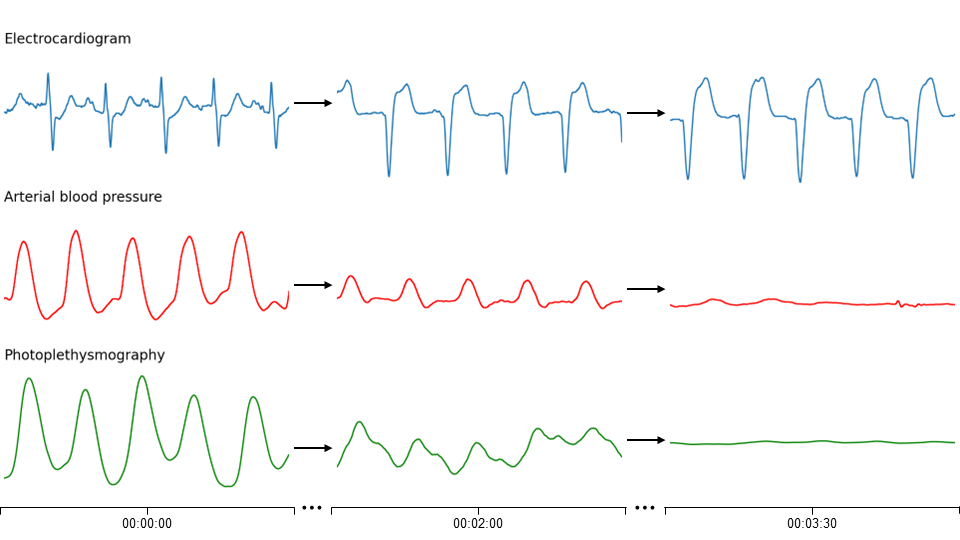Final ID: Or106
Automated cardiac arrest detection incorporated in a wristband: First experience with spontaneous cardiac arrest detection
Abstract Body: Introduction
Survival from out-of-hospital cardiac arrest depends on immediate recognition and early cardiopulmonary resuscitation. Especially for unwitnessed cardiac arrest, survival chances are poor due to delays in receiving help. Automated cardiac arrest detection using wearables could facilitate early help. In the DETECT-1 study, an algorithm for circulatory arrest detection was developed using wrist-derived photoplethysmography (PPG) from patients with induced circulatory arrest, yielding 98% sensitivity. Next step is the validation of this algorithm in spontaneous cardiac arrest events.
Goal
This study presents the first experience with the PPG algorithm for cardiac arrest detection in hospitalized patients with spontaneous cardiac arrest.
Methods
The study population consisted of patients who underwent transcatheter aortic valve implantation (TAVI) complicated by an episode of cardiac arrest, and patients admitted to the intensive care unit (ICU) in whom life sustaining treatment was withdrawn, while wearing the PPG wristband. Continuous ECG, arterial blood pressure data, and/or procedural logs were used as reference standard. The developed PPG algorithm for cardiac arrest detection was used to study sensitivity for cardiac arrest detection. Additionally, the mean arterial pressure (MAP) and pulse pressure, determined from the arterial blood pressure at the time of the algorithm’s cardiac arrest alarm, were analyzed.
Results
A cardiac arrest occurred in 15 patients (9 TAVI patients and 6 ICU patients), of whom 2 had ventricular fibrillation, 11 pulseless electrical activity (Figure 1), and 2 asystole. Cardiac arrest was successfully detected in 14 out of the 15 patients, yielding a sensitivity of 93% (95% CI 66-100%). The false negative alarm was related to noisy PPG signal resulting from the immediate resuscitative interventions of the medical team. PPG data were identified as cardiac arrest at a median MAP of 37 mmHg (IQR 26-55 mmHg) and a median pulse pressure of 16 mmHg (IQR 6-18 mmHg). There were no false positive cardiac arrest alarms.
Conclusion
The PPG algorithm successfully detected all but one cardiac arrests, which holds promise for future implementation of wristband-based cardiac arrest detection. Moreover, there were no false positive alarms. As a the next step, the PPG algorithm needs to be validated in a larger sample of cardiac arrest events and potential false positive alarms need to be studied thoroughly during daily life use.
Survival from out-of-hospital cardiac arrest depends on immediate recognition and early cardiopulmonary resuscitation. Especially for unwitnessed cardiac arrest, survival chances are poor due to delays in receiving help. Automated cardiac arrest detection using wearables could facilitate early help. In the DETECT-1 study, an algorithm for circulatory arrest detection was developed using wrist-derived photoplethysmography (PPG) from patients with induced circulatory arrest, yielding 98% sensitivity. Next step is the validation of this algorithm in spontaneous cardiac arrest events.
Goal
This study presents the first experience with the PPG algorithm for cardiac arrest detection in hospitalized patients with spontaneous cardiac arrest.
Methods
The study population consisted of patients who underwent transcatheter aortic valve implantation (TAVI) complicated by an episode of cardiac arrest, and patients admitted to the intensive care unit (ICU) in whom life sustaining treatment was withdrawn, while wearing the PPG wristband. Continuous ECG, arterial blood pressure data, and/or procedural logs were used as reference standard. The developed PPG algorithm for cardiac arrest detection was used to study sensitivity for cardiac arrest detection. Additionally, the mean arterial pressure (MAP) and pulse pressure, determined from the arterial blood pressure at the time of the algorithm’s cardiac arrest alarm, were analyzed.
Results
A cardiac arrest occurred in 15 patients (9 TAVI patients and 6 ICU patients), of whom 2 had ventricular fibrillation, 11 pulseless electrical activity (Figure 1), and 2 asystole. Cardiac arrest was successfully detected in 14 out of the 15 patients, yielding a sensitivity of 93% (95% CI 66-100%). The false negative alarm was related to noisy PPG signal resulting from the immediate resuscitative interventions of the medical team. PPG data were identified as cardiac arrest at a median MAP of 37 mmHg (IQR 26-55 mmHg) and a median pulse pressure of 16 mmHg (IQR 6-18 mmHg). There were no false positive cardiac arrest alarms.
Conclusion
The PPG algorithm successfully detected all but one cardiac arrests, which holds promise for future implementation of wristband-based cardiac arrest detection. Moreover, there were no false positive alarms. As a the next step, the PPG algorithm needs to be validated in a larger sample of cardiac arrest events and potential false positive alarms need to be studied thoroughly during daily life use.
More abstracts on this topic:
Association of Sleep Temperature Patterns with Resting Heart Rate in Regular and Irregular Menstrual Cycles using Wearables: a real-world cross-sectional study
Gupta Kanika, Ippili Sai Prasad, Pirrie Al, Hendi Apurva, Davies Kate, Milnes Rob, Bhattacharya Aditi
A Rare Case of Adalimumab-Induced Cardiac Tamponade in a Patient with Psoriatic ArthritisRaval Akhinav, Tran Minh, Saini Ishveen, Rea Mark

